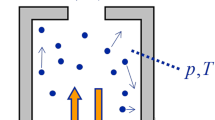Abstract
Several methods are established in thermal analysis to investigate phase formation, phase transition, and decomposition reactions. The analysis of phase equilibria with volatile components is particularly feasible by using standard method of thermogravimetry. Hardly any investigations of phase formation reactions are possible to realize if one of the components is lost by vaporization. By using the “High-Temperature Gas-Balance” (HTGB), the vapor phase is enclosed in a silica ampoule and thus forms an equilibrium gas phase in permanent contact with the solid phase. The measurement signal Δm meas is caused by change of the leverage of the horizontal balance support during evaporation and condensation. The application of the HTGB allows the analysis of solid–gas equilibria in the working range from 0.01 till 15 bar at temperatures up to 1,100 °C. The first comparison of evaporation reactions determined by standard thermogravimetric analyses and by measurements using the HTGB is given for the inorganic systems: P, As, SeO2, PtI2, and Hg/I.










Similar content being viewed by others
References
Brown ME. Handbook of thermal analysis and calorimetry, vol. 3. Amsterdam: Elsevier Science Ltd; 1998.
Haines P. Principles of thermal analysis and calorimetry. London: Royal Society of Chemistry; 2002.
Amankwah RK, Pickles CA. Thermodynamic, thermogravimetric and permittivity studies of hausmannite (Mn3O4) in air. J Thermal Anal Calorim. 2009;98:849–53.
Sergent N, Gelin P, Perier-Camby L, Praliaud H, Thomas G. Study of the interactions between carbon monoxide and high specific surface area tin dioxide. Thermogravimetric analysis and FTIR spectroscopy. J Thermal Anal Calorim. 2003;72:1117–26.
Hackert A, Plies V. Determination of temperature dependent partial pressures in closed systems—a new method. Z Anorg Allg Chem. 1998;624:74–80.
Martienssen W, Warlimont H. Springer handbook of condensed matter and materials data. Berlin: Springer; 2005.
Knacke O, Kubaschevski O, Hesselmann K. Thermochemical properties of inorganic substances. 2nd ed. Berlin: Springer; 1991.
Barin I. Thermochemical data of pure substances. Weinheim: VCH Verlagsgesellschaft; 1989.
Binnewies M, Milke E. Thermochemical data of elements. Weinheim: Wiley-VCH; 1999.
Riesen R. Adjustment of heating rate for maximum resolution in TG and TMA. J Thermal Anal Calorim. 1998;53:365–74.
Krabbes G, Bieger W, Sommer KH, Söhnel T, Steiner U. GMIN Version 5.0b, package TRAGMIN for calculation of thermodynamic equilibrium. Dresden: IFW Dresden, TU Dresden; 2008.
Schmidt P. Thermodynamic analysis of existence ranges of solid phases- principles of syntheses planning in inorganic solid state chemistry. Habilitation, TU Dresden; 2007. http://nbn-resolving.de/urn:nbn:de:bsz:14-ds-1200397971615-40549.
Schmidt P, Oppermann H, Feja St. Thermal decomposition of TeSeO4 and Te3SeO8. Z Anorg Allg Chem. 2001;627:1958–65.
Schäfer H, Trenkel B. The iodine catalyzed sublimation of red phosphorus. Z Anorg Allg Chem. 1972;391:11–8.
Lange S, Schmidt P, Nilges T. Au3Snp7@black phosphorus: an easy access to black phosphorus. Inorg Chem. 2007;46:4028–35.
Roth WL, Dewitt T, Smith AJ. Polymorphism of red phosphorus. J Am Chem Soc. 1947;69(11):2881–5.
Acknowledgements
The authors greatly acknowledge the financial support by the Priority program—Schwerpunktprogramm 1415 of the German research funding organization—Deutsche Forschungsgemeinschaft (DFG). The high-temperature materials and furnaces specialist HTM Reetz (http://www.htm-reetz.de/en/index.asp) is gratefully acknowledged for the technical support in construction and optimization of the High-Temperature Gas-Balance.
Author information
Authors and Affiliations
Corresponding author
Rights and permissions
About this article
Cite this article
Schmidt, P., Schöneich, M., Bawohl, M. et al. The use of the High-Temperature Gas-Balance (HTGB) for thermogravimetric measurements. J Therm Anal Calorim 110, 1511–1521 (2012). https://doi.org/10.1007/s10973-011-2107-3
Received:
Accepted:
Published:
Issue Date:
DOI: https://doi.org/10.1007/s10973-011-2107-3




